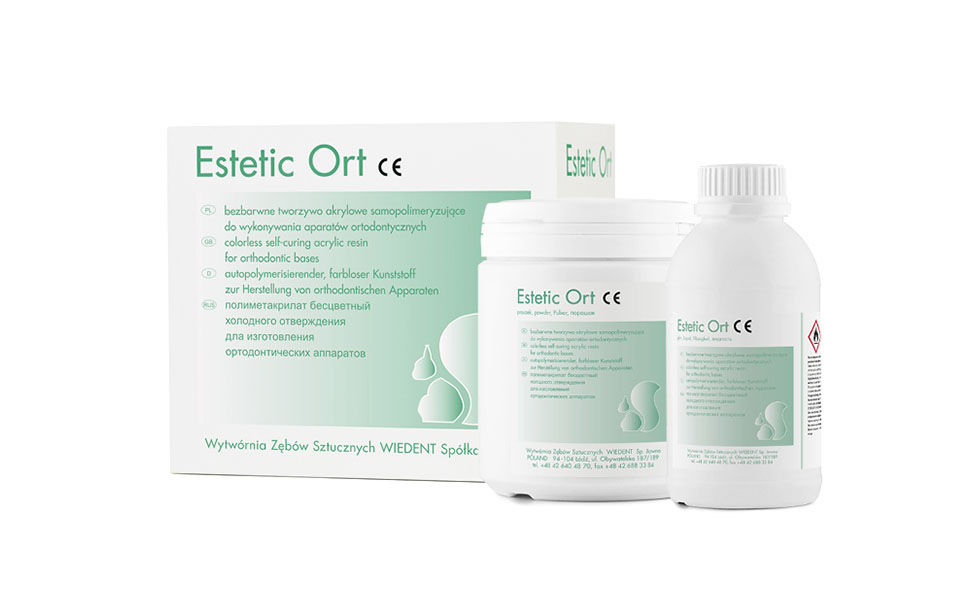Estetic Ort 
colourless self - curing acrylic resin for orthodontic bases

- possibility of using following methods:
- applying the plastic mass,
- pouring the powder ("salt and pepper"),
- dyes easily with Estetic Ort Kolor liquids,
- meets the requirements of PN-EN ISO 20795-2.
Technical data:
- mixing ratio: powder/liquid by weight - 3:1
- dough time: 2-5 minutes,
- working time: 2,5 minutes,
- curing time: 20 minutes at 40-50°C, 2 bar,
- fracture strength: 66,5 MPa,
- deflection module: 2043 MPa,
- water solubility: 2,6 μg/mm3,
- water sorption: 12,0 μg/mm3.
Packaging:
Sets:
- 2000 g powder, 1000 ml liquid,
- 500 g powder, 250 ml liquid.
Application:
- for making transparent bases of orthodontic apparatuses.
Properties:
- self-curing polymer,
- possibility of using following methods: I ; applying the plastic mass, II ; pouring the powder ("salt and pepper"),
- dyes easily with ESTETIC ORT KOLOR concentrates,
- meets the requirements of international standard PN-EN ISO 20795-2.
Proportions for mixing:
Recommended weight proportions of powder and liquid are like 3:1.
Direction for use and polymerising:
Fasten the metal tooth-correction elements to the plaster model by using some wax. Moisten the model covered with a layer of isolating substance and apply the material following the described below methods.
(Should the orthodontic apparatus bases require to be coloured, the liquid should first be dyed with ESTETIC ORT KOLOR concentrates according to their use directions).
I – Applying the plastic mass method:
Pour a suitable quantity of liquid into a pot. Add the powder little by little until it is completely saturated with the liquid. Stir for a few seconds – the solution should have the consistency of thick cream.
Close the pot tightly and leave it covered for about 2 - 5 minutes (depending on the temperature of the environment). Higher temperatures accelerate polymerisation, while lower temperatures delay this process.
Check for plasticity with a spatula. When the material appears to have reached the stage of the highest plasticity (just after the phase of "drawing thread") it can be applied.
Spread the plastic material around the surface of the model and press gradually into a polymerising mould.
II – The powder-pouring method ("salt and pepper")
Pour a layer of the powder on the surface of the model and moisten it with some liquid. Repeat until the correctly thickened plate for the orthodontic apparatuses has been obtained.
Apparatuses prepared in accordance with any of the methods described above should be polymerised in water at 40-50°C under the pressure of 2 bar for about 20 minutes.
The polymerised orthodontic apparatus can be processed and polished in the usual manner.
The manufacturer recommends inserting the following information in the instructions for patients:
- orthodontic apparatuses should be washed with a tooth-brush and toothpaste or any other agents especially designed for the care of such products,
- don't soak them in heavily alkali or acid substances in order to avoid damage of surface,
- damaged orthodontic apparatuses should be repaired only by a dental technician or a dentist,
- the adjustment of orthodontic apparatuses should be regularly checked.
Storage:
Keep in tightly-closed containers in well-ventilated rooms. Keep out of the reach of children.
Best before: 3 years from the date of production.
WARNING:
The liquid is inflammable and also irritant. Avoid inhaling the vapours and prevent any contact with the skin and eyes. In case of contact, rinse thoroughly with water and, if any, contact your ophthalmologist.
Don't dispose of the remainder of the liquid into the sewer. Dental technicians are warned against inhaling dust while carrying out prosthesis work.
When engaged in this work, using of a dust-mask and a fume cupboard is recommended.
- Instruction
- Instructions for use of ESTETIC ORT
- Declaration of Conformity
- Declaration of Conformity ESTETIC ORT
- Order form
- Auxiliary products
- Safety Data Sheet
- SDS_Est Ort_Est Ort Kolor_ liquid
- Catalogue page
- Estetic Ort
